Air New Zealand Case Study: Analyzing Critical Issues in Management
VerifiedAdded on 2023/06/04
|11
|2541
|415
Case Study
AI Summary
This case study provides an analysis of Air New Zealand, focusing on critical management issues and strategic challenges. It begins with an overview of the company's history and its commitment to customer service and sustainability. The report uses SWOT and PESTEL analyses to evaluate the external and internal factors affecting the airline's performance, including its strengths, weaknesses, opportunities, and threats, as well as political, economic, social, technological, legal, and environmental considerations. Key issues identified include government influence, economic volatility, social trends, technological advancements, legal factors, and environmental concerns. The analysis also touches upon the company's leadership style and its impact on strategic decisions. The study concludes by suggesting recommendations based on the strategic plan, highlighting associated benefits and risks.
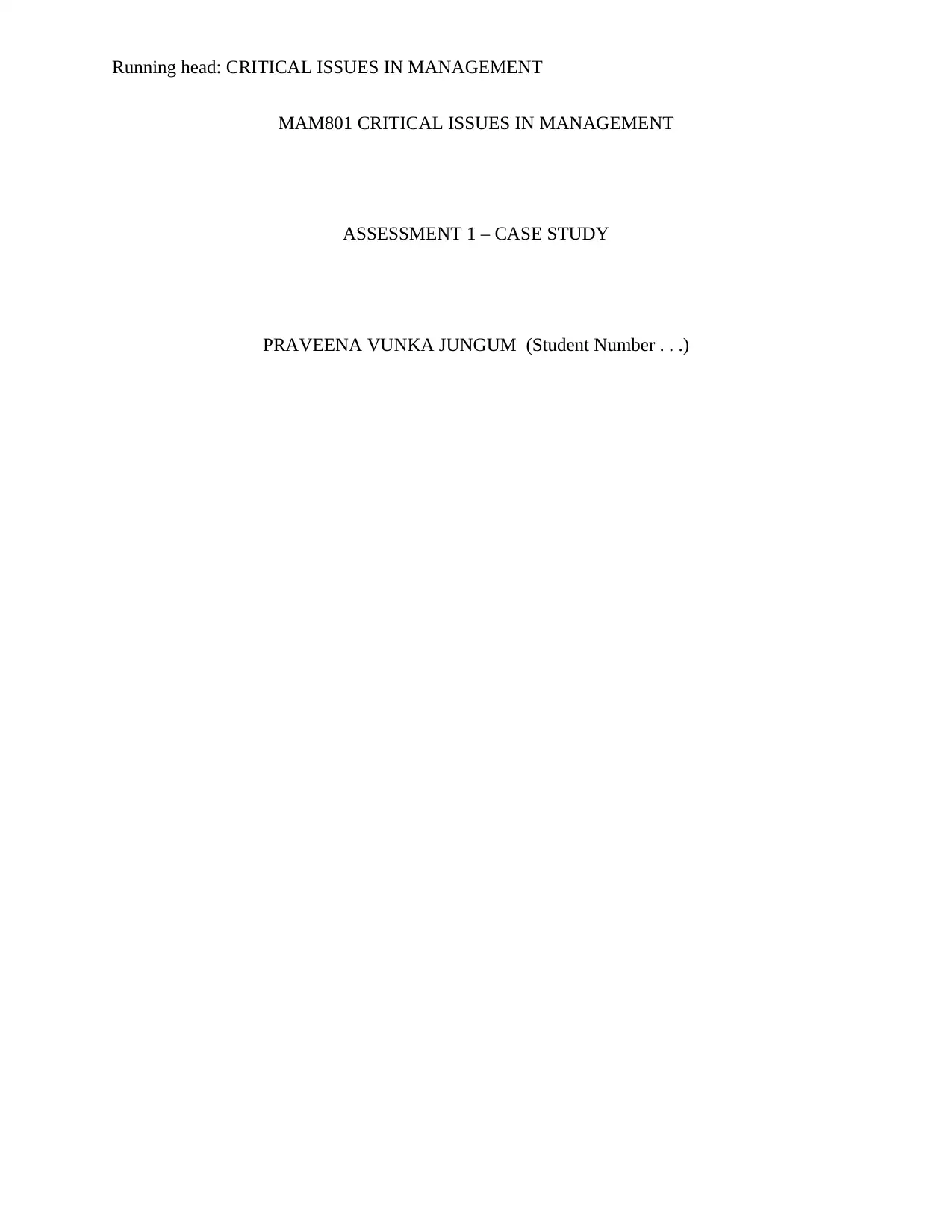
Running head: CRITICAL ISSUES IN MANAGEMENT
MAM801 CRITICAL ISSUES IN MANAGEMENT
ASSESSMENT 1 – CASE STUDY
PRAVEENA VUNKA JUNGUM (Student Number . . .)
MAM801 CRITICAL ISSUES IN MANAGEMENT
ASSESSMENT 1 – CASE STUDY
PRAVEENA VUNKA JUNGUM (Student Number . . .)
Paraphrase This Document
Need a fresh take? Get an instant paraphrase of this document with our AI Paraphraser
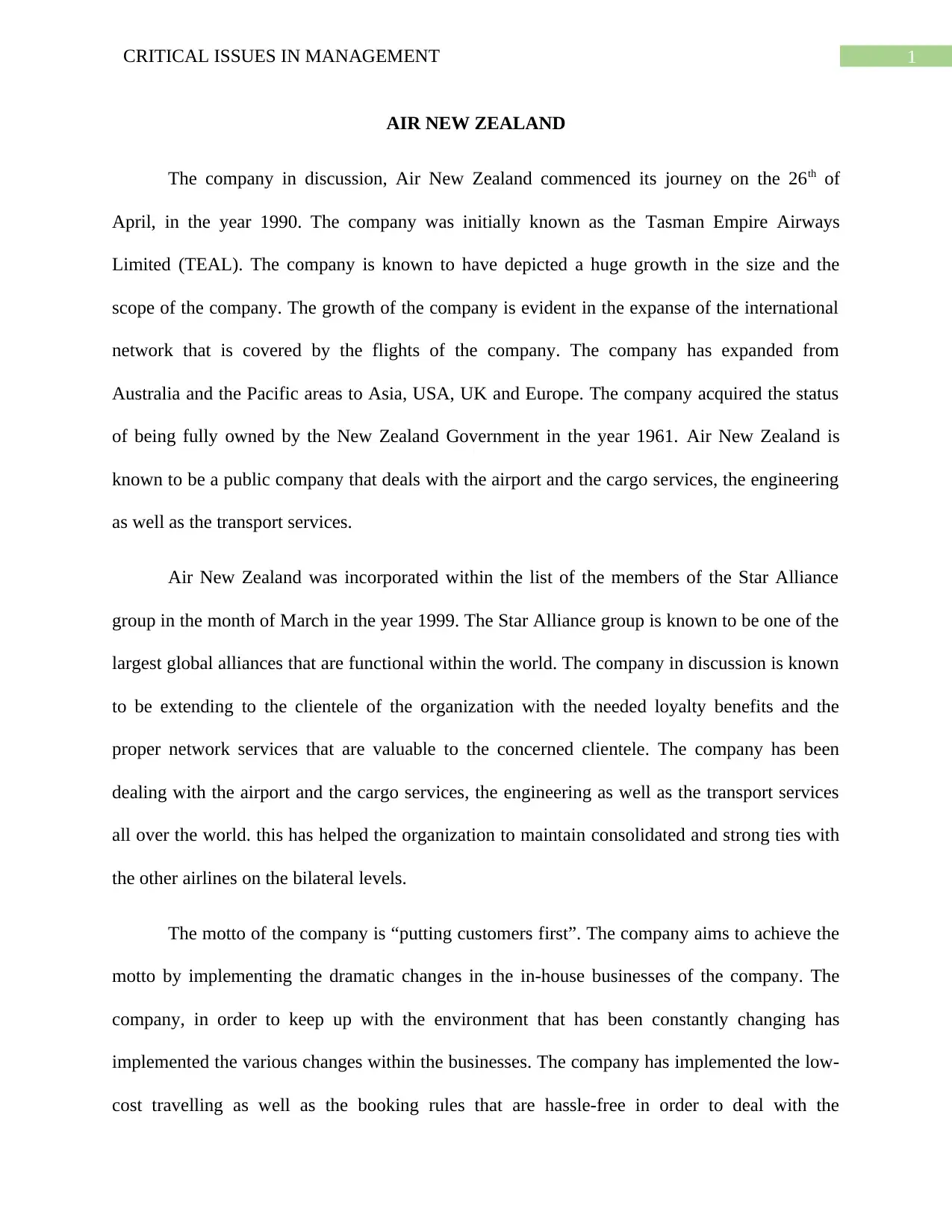
1CRITICAL ISSUES IN MANAGEMENT
AIR NEW ZEALAND
The company in discussion, Air New Zealand commenced its journey on the 26th of
April, in the year 1990. The company was initially known as the Tasman Empire Airways
Limited (TEAL). The company is known to have depicted a huge growth in the size and the
scope of the company. The growth of the company is evident in the expanse of the international
network that is covered by the flights of the company. The company has expanded from
Australia and the Pacific areas to Asia, USA, UK and Europe. The company acquired the status
of being fully owned by the New Zealand Government in the year 1961. Air New Zealand is
known to be a public company that deals with the airport and the cargo services, the engineering
as well as the transport services.
Air New Zealand was incorporated within the list of the members of the Star Alliance
group in the month of March in the year 1999. The Star Alliance group is known to be one of the
largest global alliances that are functional within the world. The company in discussion is known
to be extending to the clientele of the organization with the needed loyalty benefits and the
proper network services that are valuable to the concerned clientele. The company has been
dealing with the airport and the cargo services, the engineering as well as the transport services
all over the world. this has helped the organization to maintain consolidated and strong ties with
the other airlines on the bilateral levels.
The motto of the company is “putting customers first”. The company aims to achieve the
motto by implementing the dramatic changes in the in-house businesses of the company. The
company, in order to keep up with the environment that has been constantly changing has
implemented the various changes within the businesses. The company has implemented the low-
cost travelling as well as the booking rules that are hassle-free in order to deal with the
AIR NEW ZEALAND
The company in discussion, Air New Zealand commenced its journey on the 26th of
April, in the year 1990. The company was initially known as the Tasman Empire Airways
Limited (TEAL). The company is known to have depicted a huge growth in the size and the
scope of the company. The growth of the company is evident in the expanse of the international
network that is covered by the flights of the company. The company has expanded from
Australia and the Pacific areas to Asia, USA, UK and Europe. The company acquired the status
of being fully owned by the New Zealand Government in the year 1961. Air New Zealand is
known to be a public company that deals with the airport and the cargo services, the engineering
as well as the transport services.
Air New Zealand was incorporated within the list of the members of the Star Alliance
group in the month of March in the year 1999. The Star Alliance group is known to be one of the
largest global alliances that are functional within the world. The company in discussion is known
to be extending to the clientele of the organization with the needed loyalty benefits and the
proper network services that are valuable to the concerned clientele. The company has been
dealing with the airport and the cargo services, the engineering as well as the transport services
all over the world. this has helped the organization to maintain consolidated and strong ties with
the other airlines on the bilateral levels.
The motto of the company is “putting customers first”. The company aims to achieve the
motto by implementing the dramatic changes in the in-house businesses of the company. The
company, in order to keep up with the environment that has been constantly changing has
implemented the various changes within the businesses. The company has implemented the low-
cost travelling as well as the booking rules that are hassle-free in order to deal with the
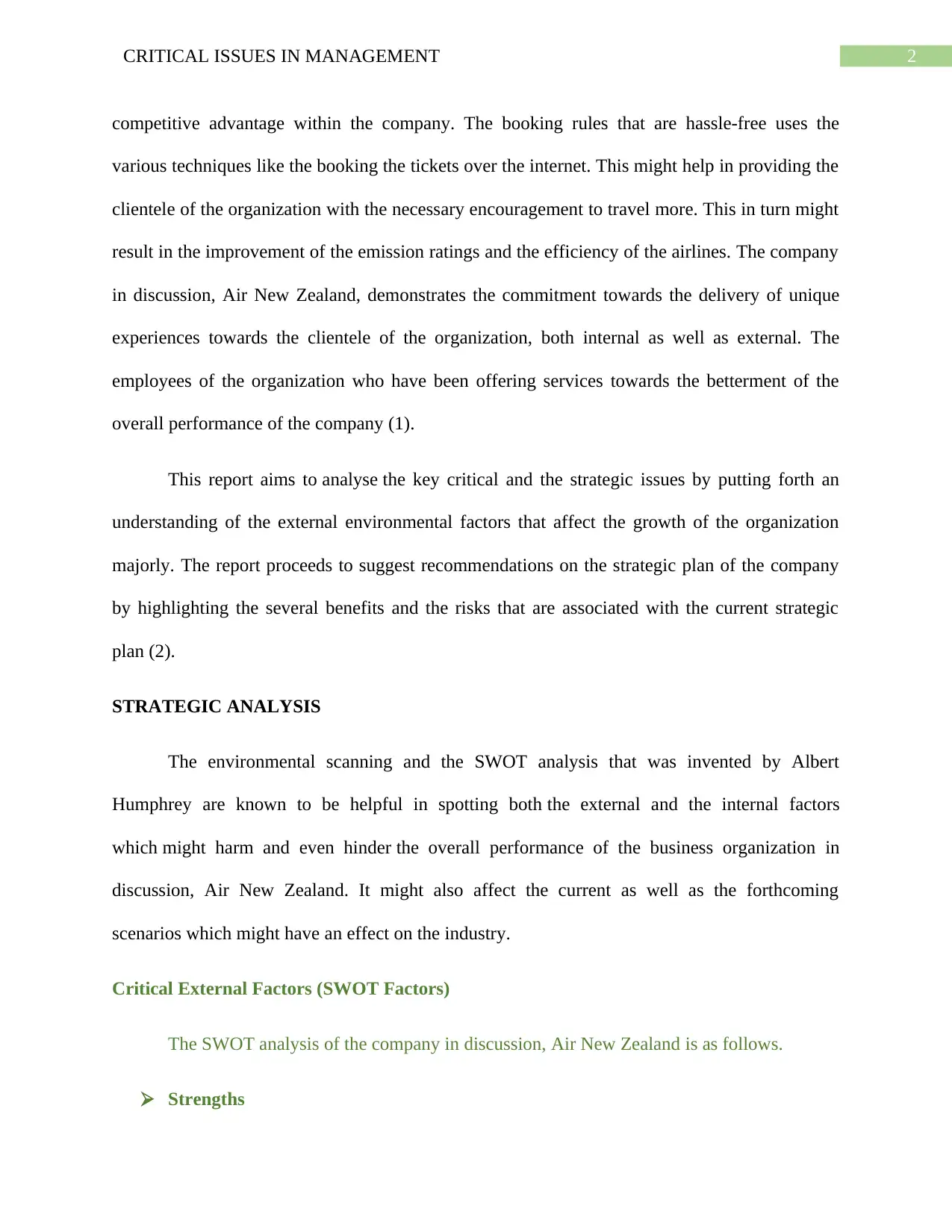
2CRITICAL ISSUES IN MANAGEMENT
competitive advantage within the company. The booking rules that are hassle-free uses the
various techniques like the booking the tickets over the internet. This might help in providing the
clientele of the organization with the necessary encouragement to travel more. This in turn might
result in the improvement of the emission ratings and the efficiency of the airlines. The company
in discussion, Air New Zealand, demonstrates the commitment towards the delivery of unique
experiences towards the clientele of the organization, both internal as well as external. The
employees of the organization who have been offering services towards the betterment of the
overall performance of the company (1).
This report aims to analyse the key critical and the strategic issues by putting forth an
understanding of the external environmental factors that affect the growth of the organization
majorly. The report proceeds to suggest recommendations on the strategic plan of the company
by highlighting the several benefits and the risks that are associated with the current strategic
plan (2).
STRATEGIC ANALYSIS
The environmental scanning and the SWOT analysis that was invented by Albert
Humphrey are known to be helpful in spotting both the external and the internal factors
which might harm and even hinder the overall performance of the business organization in
discussion, Air New Zealand. It might also affect the current as well as the forthcoming
scenarios which might have an effect on the industry.
Critical External Factors (SWOT Factors)
The SWOT analysis of the company in discussion, Air New Zealand is as follows.
Strengths
competitive advantage within the company. The booking rules that are hassle-free uses the
various techniques like the booking the tickets over the internet. This might help in providing the
clientele of the organization with the necessary encouragement to travel more. This in turn might
result in the improvement of the emission ratings and the efficiency of the airlines. The company
in discussion, Air New Zealand, demonstrates the commitment towards the delivery of unique
experiences towards the clientele of the organization, both internal as well as external. The
employees of the organization who have been offering services towards the betterment of the
overall performance of the company (1).
This report aims to analyse the key critical and the strategic issues by putting forth an
understanding of the external environmental factors that affect the growth of the organization
majorly. The report proceeds to suggest recommendations on the strategic plan of the company
by highlighting the several benefits and the risks that are associated with the current strategic
plan (2).
STRATEGIC ANALYSIS
The environmental scanning and the SWOT analysis that was invented by Albert
Humphrey are known to be helpful in spotting both the external and the internal factors
which might harm and even hinder the overall performance of the business organization in
discussion, Air New Zealand. It might also affect the current as well as the forthcoming
scenarios which might have an effect on the industry.
Critical External Factors (SWOT Factors)
The SWOT analysis of the company in discussion, Air New Zealand is as follows.
Strengths
⊘ This is a preview!⊘
Do you want full access?
Subscribe today to unlock all pages.

Trusted by 1+ million students worldwide
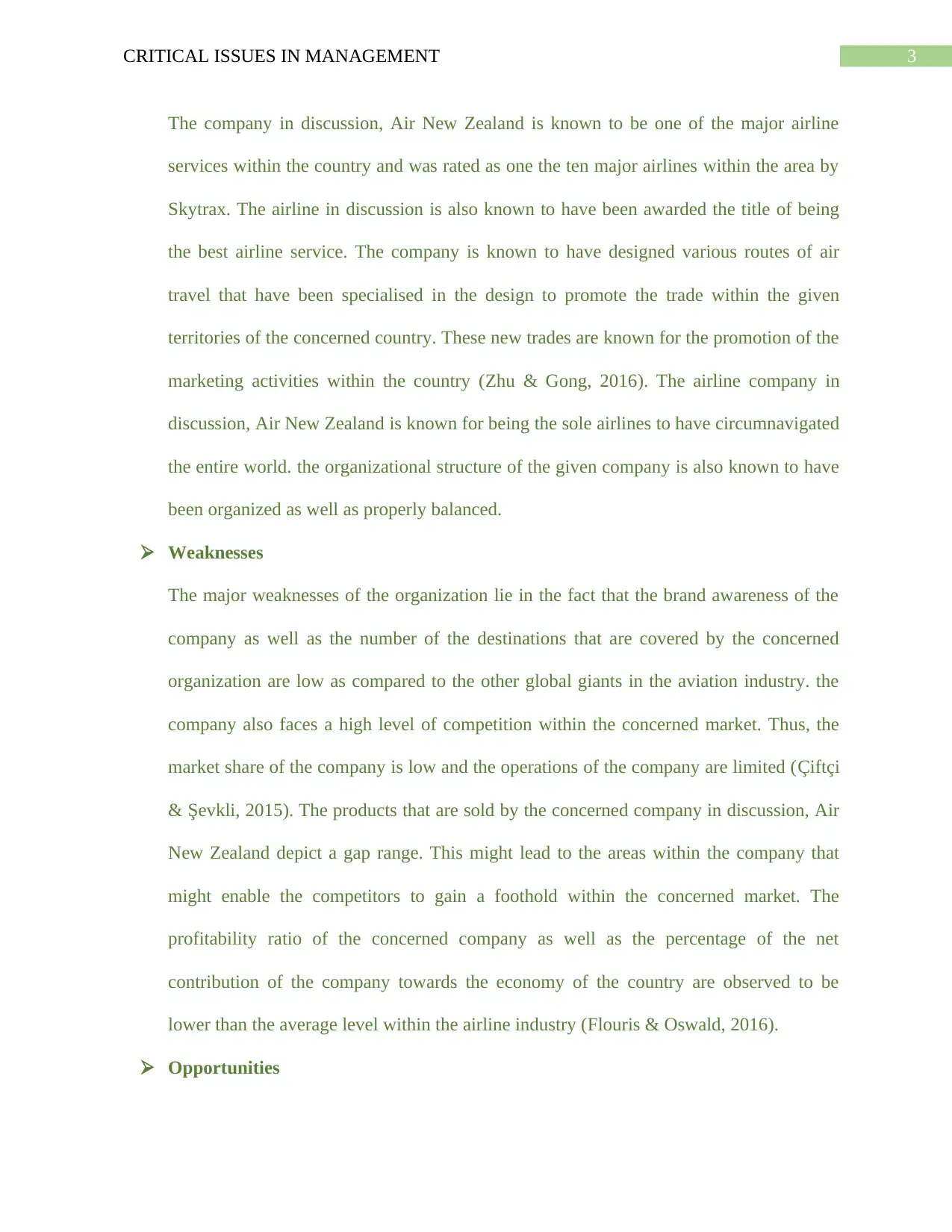
3CRITICAL ISSUES IN MANAGEMENT
The company in discussion, Air New Zealand is known to be one of the major airline
services within the country and was rated as one the ten major airlines within the area by
Skytrax. The airline in discussion is also known to have been awarded the title of being
the best airline service. The company is known to have designed various routes of air
travel that have been specialised in the design to promote the trade within the given
territories of the concerned country. These new trades are known for the promotion of the
marketing activities within the country (Zhu & Gong, 2016). The airline company in
discussion, Air New Zealand is known for being the sole airlines to have circumnavigated
the entire world. the organizational structure of the given company is also known to have
been organized as well as properly balanced.
Weaknesses
The major weaknesses of the organization lie in the fact that the brand awareness of the
company as well as the number of the destinations that are covered by the concerned
organization are low as compared to the other global giants in the aviation industry. the
company also faces a high level of competition within the concerned market. Thus, the
market share of the company is low and the operations of the company are limited (Çiftçi
& Şevkli, 2015). The products that are sold by the concerned company in discussion, Air
New Zealand depict a gap range. This might lead to the areas within the company that
might enable the competitors to gain a foothold within the concerned market. The
profitability ratio of the concerned company as well as the percentage of the net
contribution of the company towards the economy of the country are observed to be
lower than the average level within the airline industry (Flouris & Oswald, 2016).
Opportunities
The company in discussion, Air New Zealand is known to be one of the major airline
services within the country and was rated as one the ten major airlines within the area by
Skytrax. The airline in discussion is also known to have been awarded the title of being
the best airline service. The company is known to have designed various routes of air
travel that have been specialised in the design to promote the trade within the given
territories of the concerned country. These new trades are known for the promotion of the
marketing activities within the country (Zhu & Gong, 2016). The airline company in
discussion, Air New Zealand is known for being the sole airlines to have circumnavigated
the entire world. the organizational structure of the given company is also known to have
been organized as well as properly balanced.
Weaknesses
The major weaknesses of the organization lie in the fact that the brand awareness of the
company as well as the number of the destinations that are covered by the concerned
organization are low as compared to the other global giants in the aviation industry. the
company also faces a high level of competition within the concerned market. Thus, the
market share of the company is low and the operations of the company are limited (Çiftçi
& Şevkli, 2015). The products that are sold by the concerned company in discussion, Air
New Zealand depict a gap range. This might lead to the areas within the company that
might enable the competitors to gain a foothold within the concerned market. The
profitability ratio of the concerned company as well as the percentage of the net
contribution of the company towards the economy of the country are observed to be
lower than the average level within the airline industry (Flouris & Oswald, 2016).
Opportunities
Paraphrase This Document
Need a fresh take? Get an instant paraphrase of this document with our AI Paraphraser
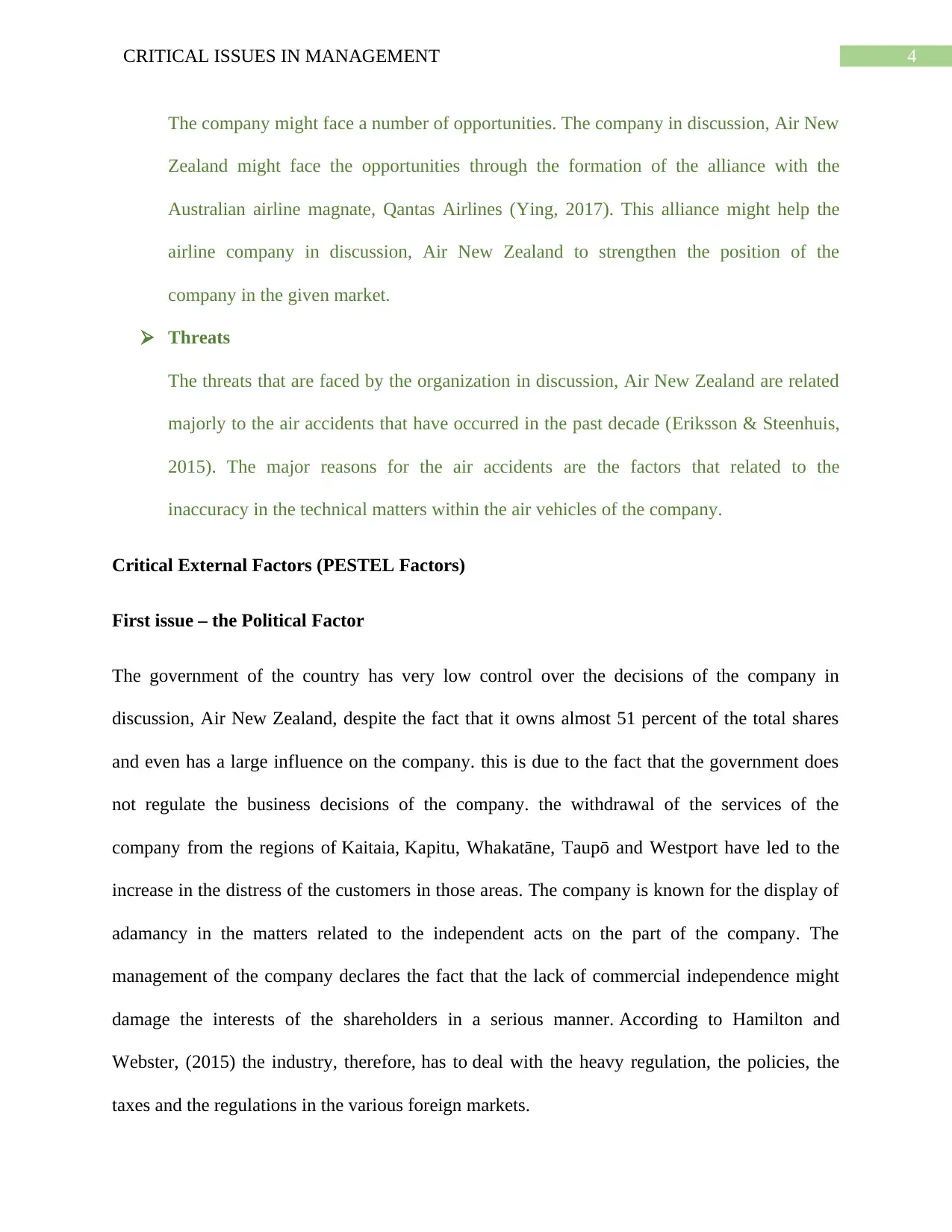
4CRITICAL ISSUES IN MANAGEMENT
The company might face a number of opportunities. The company in discussion, Air New
Zealand might face the opportunities through the formation of the alliance with the
Australian airline magnate, Qantas Airlines (Ying, 2017). This alliance might help the
airline company in discussion, Air New Zealand to strengthen the position of the
company in the given market.
Threats
The threats that are faced by the organization in discussion, Air New Zealand are related
majorly to the air accidents that have occurred in the past decade (Eriksson & Steenhuis,
2015). The major reasons for the air accidents are the factors that related to the
inaccuracy in the technical matters within the air vehicles of the company.
Critical External Factors (PESTEL Factors)
First issue – the Political Factor
The government of the country has very low control over the decisions of the company in
discussion, Air New Zealand, despite the fact that it owns almost 51 percent of the total shares
and even has a large influence on the company. this is due to the fact that the government does
not regulate the business decisions of the company. the withdrawal of the services of the
company from the regions of Kaitaia, Kapitu, Whakatāne, Taupō and Westport have led to the
increase in the distress of the customers in those areas. The company is known for the display of
adamancy in the matters related to the independent acts on the part of the company. The
management of the company declares the fact that the lack of commercial independence might
damage the interests of the shareholders in a serious manner. According to Hamilton and
Webster, (2015) the industry, therefore, has to deal with the heavy regulation, the policies, the
taxes and the regulations in the various foreign markets.
The company might face a number of opportunities. The company in discussion, Air New
Zealand might face the opportunities through the formation of the alliance with the
Australian airline magnate, Qantas Airlines (Ying, 2017). This alliance might help the
airline company in discussion, Air New Zealand to strengthen the position of the
company in the given market.
Threats
The threats that are faced by the organization in discussion, Air New Zealand are related
majorly to the air accidents that have occurred in the past decade (Eriksson & Steenhuis,
2015). The major reasons for the air accidents are the factors that related to the
inaccuracy in the technical matters within the air vehicles of the company.
Critical External Factors (PESTEL Factors)
First issue – the Political Factor
The government of the country has very low control over the decisions of the company in
discussion, Air New Zealand, despite the fact that it owns almost 51 percent of the total shares
and even has a large influence on the company. this is due to the fact that the government does
not regulate the business decisions of the company. the withdrawal of the services of the
company from the regions of Kaitaia, Kapitu, Whakatāne, Taupō and Westport have led to the
increase in the distress of the customers in those areas. The company is known for the display of
adamancy in the matters related to the independent acts on the part of the company. The
management of the company declares the fact that the lack of commercial independence might
damage the interests of the shareholders in a serious manner. According to Hamilton and
Webster, (2015) the industry, therefore, has to deal with the heavy regulation, the policies, the
taxes and the regulations in the various foreign markets.
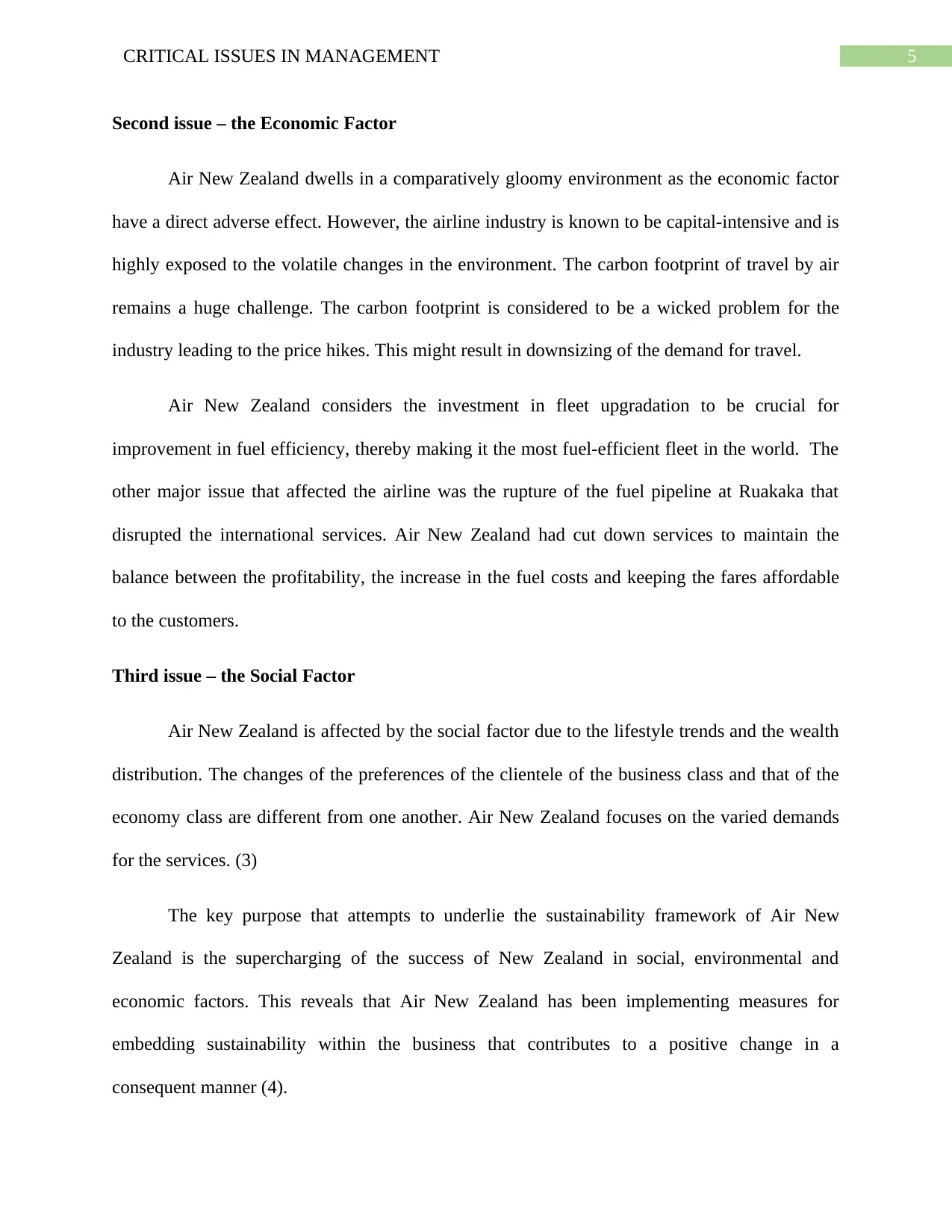
5CRITICAL ISSUES IN MANAGEMENT
Second issue – the Economic Factor
Air New Zealand dwells in a comparatively gloomy environment as the economic factor
have a direct adverse effect. However, the airline industry is known to be capital-intensive and is
highly exposed to the volatile changes in the environment. The carbon footprint of travel by air
remains a huge challenge. The carbon footprint is considered to be a wicked problem for the
industry leading to the price hikes. This might result in downsizing of the demand for travel.
Air New Zealand considers the investment in fleet upgradation to be crucial for
improvement in fuel efficiency, thereby making it the most fuel-efficient fleet in the world. The
other major issue that affected the airline was the rupture of the fuel pipeline at Ruakaka that
disrupted the international services. Air New Zealand had cut down services to maintain the
balance between the profitability, the increase in the fuel costs and keeping the fares affordable
to the customers.
Third issue – the Social Factor
Air New Zealand is affected by the social factor due to the lifestyle trends and the wealth
distribution. The changes of the preferences of the clientele of the business class and that of the
economy class are different from one another. Air New Zealand focuses on the varied demands
for the services. (3)
The key purpose that attempts to underlie the sustainability framework of Air New
Zealand is the supercharging of the success of New Zealand in social, environmental and
economic factors. This reveals that Air New Zealand has been implementing measures for
embedding sustainability within the business that contributes to a positive change in a
consequent manner (4).
Second issue – the Economic Factor
Air New Zealand dwells in a comparatively gloomy environment as the economic factor
have a direct adverse effect. However, the airline industry is known to be capital-intensive and is
highly exposed to the volatile changes in the environment. The carbon footprint of travel by air
remains a huge challenge. The carbon footprint is considered to be a wicked problem for the
industry leading to the price hikes. This might result in downsizing of the demand for travel.
Air New Zealand considers the investment in fleet upgradation to be crucial for
improvement in fuel efficiency, thereby making it the most fuel-efficient fleet in the world. The
other major issue that affected the airline was the rupture of the fuel pipeline at Ruakaka that
disrupted the international services. Air New Zealand had cut down services to maintain the
balance between the profitability, the increase in the fuel costs and keeping the fares affordable
to the customers.
Third issue – the Social Factor
Air New Zealand is affected by the social factor due to the lifestyle trends and the wealth
distribution. The changes of the preferences of the clientele of the business class and that of the
economy class are different from one another. Air New Zealand focuses on the varied demands
for the services. (3)
The key purpose that attempts to underlie the sustainability framework of Air New
Zealand is the supercharging of the success of New Zealand in social, environmental and
economic factors. This reveals that Air New Zealand has been implementing measures for
embedding sustainability within the business that contributes to a positive change in a
consequent manner (4).
⊘ This is a preview!⊘
Do you want full access?
Subscribe today to unlock all pages.

Trusted by 1+ million students worldwide
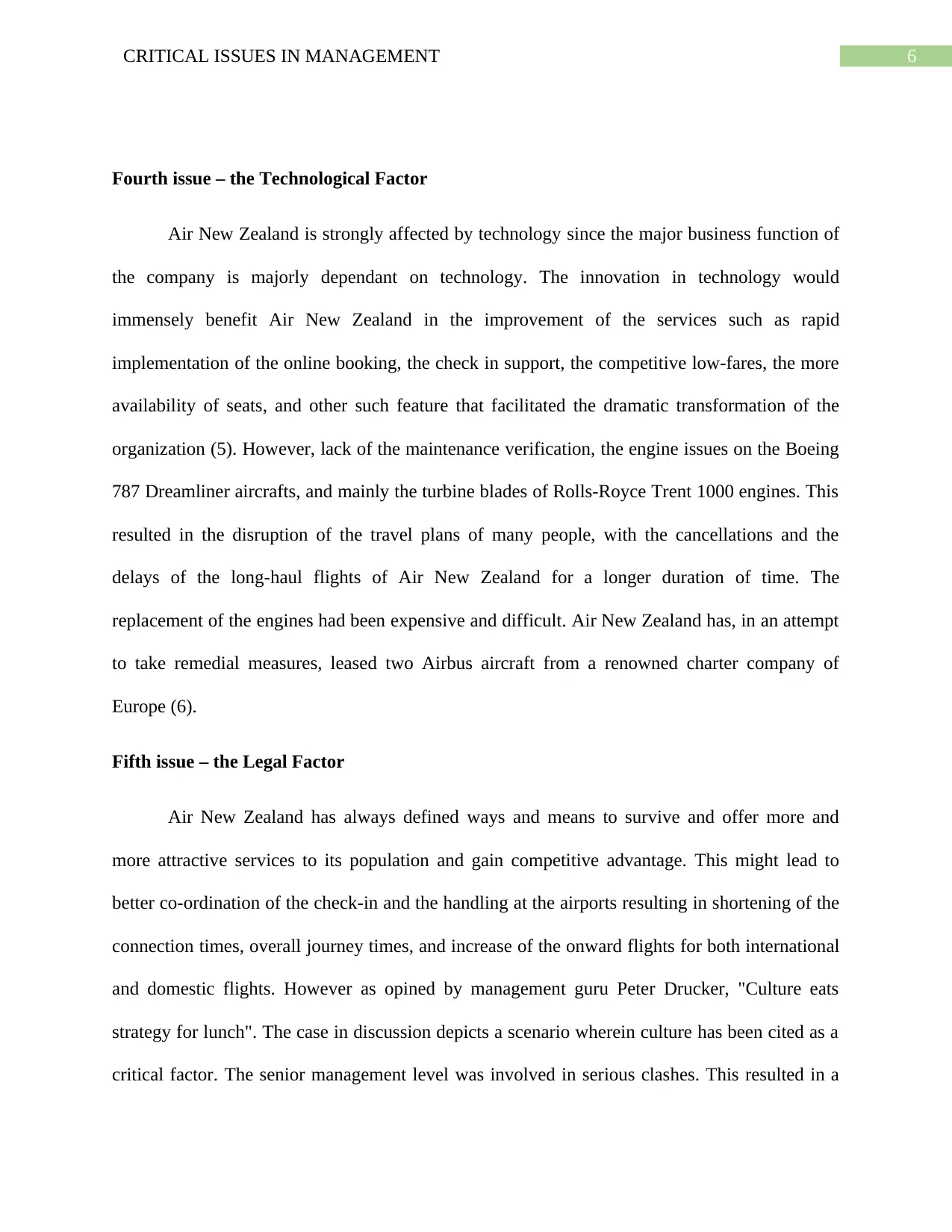
6CRITICAL ISSUES IN MANAGEMENT
Fourth issue – the Technological Factor
Air New Zealand is strongly affected by technology since the major business function of
the company is majorly dependant on technology. The innovation in technology would
immensely benefit Air New Zealand in the improvement of the services such as rapid
implementation of the online booking, the check in support, the competitive low-fares, the more
availability of seats, and other such feature that facilitated the dramatic transformation of the
organization (5). However, lack of the maintenance verification, the engine issues on the Boeing
787 Dreamliner aircrafts, and mainly the turbine blades of Rolls-Royce Trent 1000 engines. This
resulted in the disruption of the travel plans of many people, with the cancellations and the
delays of the long-haul flights of Air New Zealand for a longer duration of time. The
replacement of the engines had been expensive and difficult. Air New Zealand has, in an attempt
to take remedial measures, leased two Airbus aircraft from a renowned charter company of
Europe (6).
Fifth issue – the Legal Factor
Air New Zealand has always defined ways and means to survive and offer more and
more attractive services to its population and gain competitive advantage. This might lead to
better co-ordination of the check-in and the handling at the airports resulting in shortening of the
connection times, overall journey times, and increase of the onward flights for both international
and domestic flights. However as opined by management guru Peter Drucker, "Culture eats
strategy for lunch". The case in discussion depicts a scenario wherein culture has been cited as a
critical factor. The senior management level was involved in serious clashes. This resulted in a
Fourth issue – the Technological Factor
Air New Zealand is strongly affected by technology since the major business function of
the company is majorly dependant on technology. The innovation in technology would
immensely benefit Air New Zealand in the improvement of the services such as rapid
implementation of the online booking, the check in support, the competitive low-fares, the more
availability of seats, and other such feature that facilitated the dramatic transformation of the
organization (5). However, lack of the maintenance verification, the engine issues on the Boeing
787 Dreamliner aircrafts, and mainly the turbine blades of Rolls-Royce Trent 1000 engines. This
resulted in the disruption of the travel plans of many people, with the cancellations and the
delays of the long-haul flights of Air New Zealand for a longer duration of time. The
replacement of the engines had been expensive and difficult. Air New Zealand has, in an attempt
to take remedial measures, leased two Airbus aircraft from a renowned charter company of
Europe (6).
Fifth issue – the Legal Factor
Air New Zealand has always defined ways and means to survive and offer more and
more attractive services to its population and gain competitive advantage. This might lead to
better co-ordination of the check-in and the handling at the airports resulting in shortening of the
connection times, overall journey times, and increase of the onward flights for both international
and domestic flights. However as opined by management guru Peter Drucker, "Culture eats
strategy for lunch". The case in discussion depicts a scenario wherein culture has been cited as a
critical factor. The senior management level was involved in serious clashes. This resulted in a
Paraphrase This Document
Need a fresh take? Get an instant paraphrase of this document with our AI Paraphraser
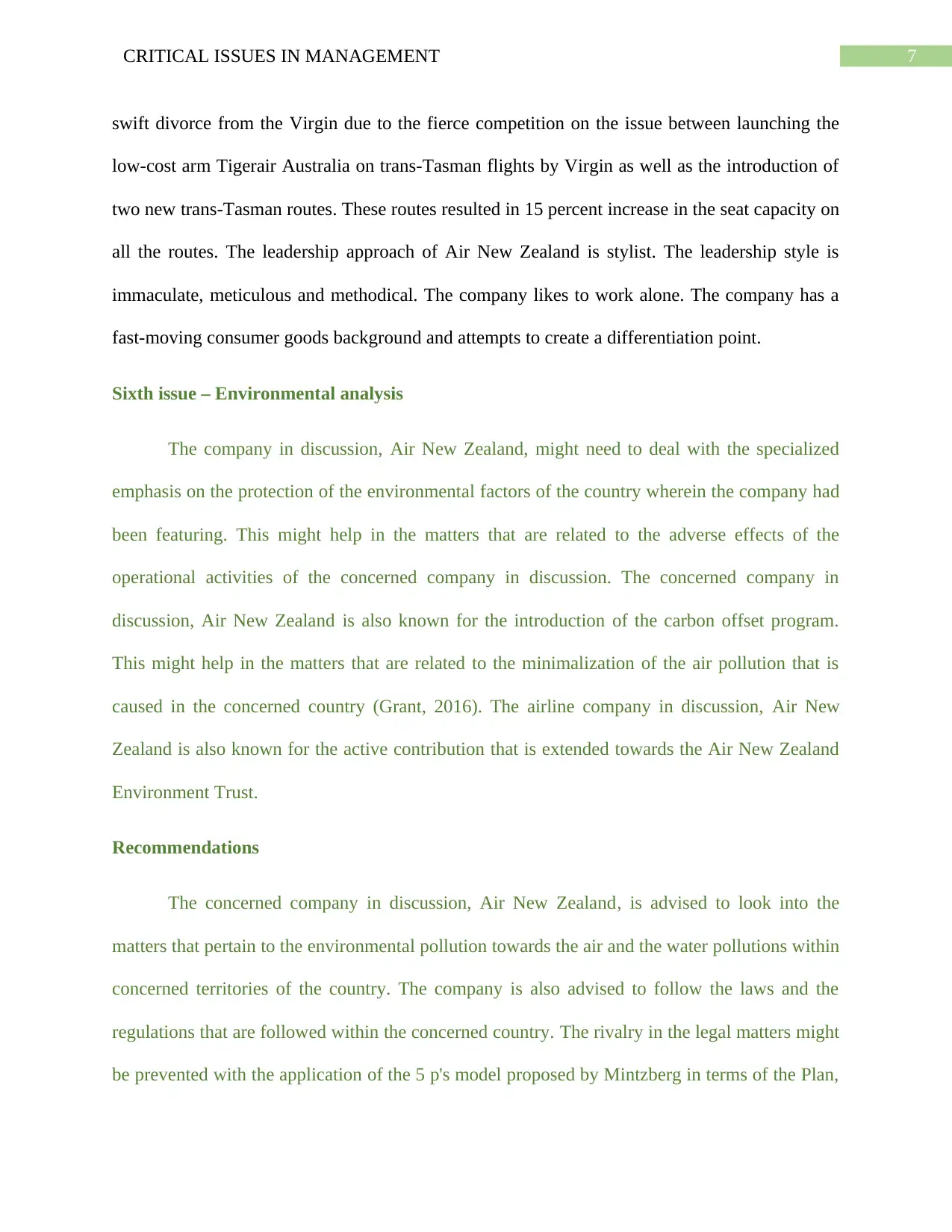
7CRITICAL ISSUES IN MANAGEMENT
swift divorce from the Virgin due to the fierce competition on the issue between launching the
low-cost arm Tigerair Australia on trans-Tasman flights by Virgin as well as the introduction of
two new trans-Tasman routes. These routes resulted in 15 percent increase in the seat capacity on
all the routes. The leadership approach of Air New Zealand is stylist. The leadership style is
immaculate, meticulous and methodical. The company likes to work alone. The company has a
fast-moving consumer goods background and attempts to create a differentiation point.
Sixth issue – Environmental analysis
The company in discussion, Air New Zealand, might need to deal with the specialized
emphasis on the protection of the environmental factors of the country wherein the company had
been featuring. This might help in the matters that are related to the adverse effects of the
operational activities of the concerned company in discussion. The concerned company in
discussion, Air New Zealand is also known for the introduction of the carbon offset program.
This might help in the matters that are related to the minimalization of the air pollution that is
caused in the concerned country (Grant, 2016). The airline company in discussion, Air New
Zealand is also known for the active contribution that is extended towards the Air New Zealand
Environment Trust.
Recommendations
The concerned company in discussion, Air New Zealand, is advised to look into the
matters that pertain to the environmental pollution towards the air and the water pollutions within
concerned territories of the country. The company is also advised to follow the laws and the
regulations that are followed within the concerned country. The rivalry in the legal matters might
be prevented with the application of the 5 p's model proposed by Mintzberg in terms of the Plan,
swift divorce from the Virgin due to the fierce competition on the issue between launching the
low-cost arm Tigerair Australia on trans-Tasman flights by Virgin as well as the introduction of
two new trans-Tasman routes. These routes resulted in 15 percent increase in the seat capacity on
all the routes. The leadership approach of Air New Zealand is stylist. The leadership style is
immaculate, meticulous and methodical. The company likes to work alone. The company has a
fast-moving consumer goods background and attempts to create a differentiation point.
Sixth issue – Environmental analysis
The company in discussion, Air New Zealand, might need to deal with the specialized
emphasis on the protection of the environmental factors of the country wherein the company had
been featuring. This might help in the matters that are related to the adverse effects of the
operational activities of the concerned company in discussion. The concerned company in
discussion, Air New Zealand is also known for the introduction of the carbon offset program.
This might help in the matters that are related to the minimalization of the air pollution that is
caused in the concerned country (Grant, 2016). The airline company in discussion, Air New
Zealand is also known for the active contribution that is extended towards the Air New Zealand
Environment Trust.
Recommendations
The concerned company in discussion, Air New Zealand, is advised to look into the
matters that pertain to the environmental pollution towards the air and the water pollutions within
concerned territories of the country. The company is also advised to follow the laws and the
regulations that are followed within the concerned country. The rivalry in the legal matters might
be prevented with the application of the 5 p's model proposed by Mintzberg in terms of the Plan,
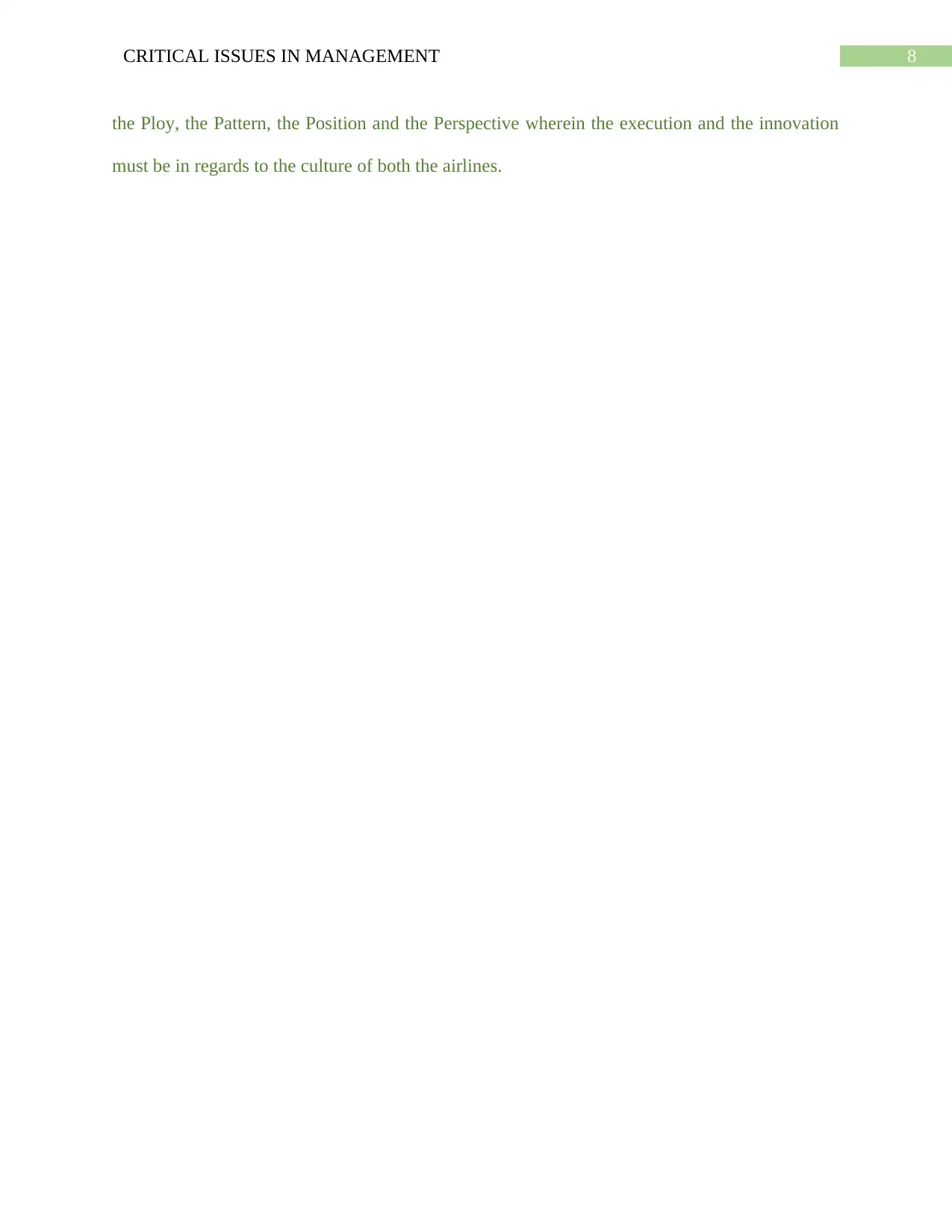
8CRITICAL ISSUES IN MANAGEMENT
the Ploy, the Pattern, the Position and the Perspective wherein the execution and the innovation
must be in regards to the culture of both the airlines.
the Ploy, the Pattern, the Position and the Perspective wherein the execution and the innovation
must be in regards to the culture of both the airlines.
⊘ This is a preview!⊘
Do you want full access?
Subscribe today to unlock all pages.

Trusted by 1+ million students worldwide
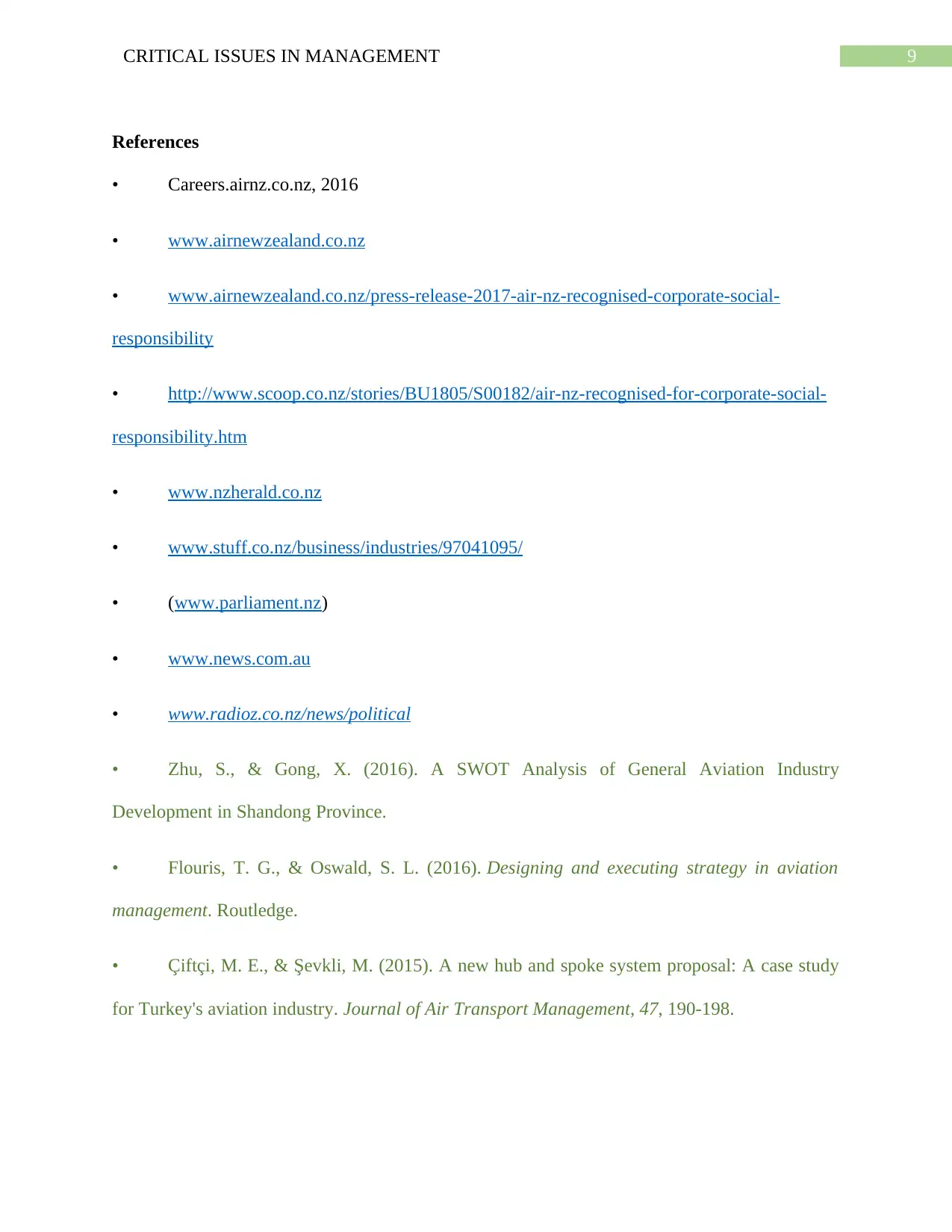
9CRITICAL ISSUES IN MANAGEMENT
References
• Careers.airnz.co.nz, 2016
• www.airnewzealand.co.nz
• www.airnewzealand.co.nz/press-release-2017-air-nz-recognised-corporate-social-
responsibility
• http://www.scoop.co.nz/stories/BU1805/S00182/air-nz-recognised-for-corporate-social-
responsibility.htm
• www.nzherald.co.nz
• www.stuff.co.nz/business/industries/97041095/
• (www.parliament.nz)
• www.news.com.au
• www.radioz.co.nz/news/political
• Zhu, S., & Gong, X. (2016). A SWOT Analysis of General Aviation Industry
Development in Shandong Province.
• Flouris, T. G., & Oswald, S. L. (2016). Designing and executing strategy in aviation
management. Routledge.
• Çiftçi, M. E., & Şevkli, M. (2015). A new hub and spoke system proposal: A case study
for Turkey's aviation industry. Journal of Air Transport Management, 47, 190-198.
References
• Careers.airnz.co.nz, 2016
• www.airnewzealand.co.nz
• www.airnewzealand.co.nz/press-release-2017-air-nz-recognised-corporate-social-
responsibility
• http://www.scoop.co.nz/stories/BU1805/S00182/air-nz-recognised-for-corporate-social-
responsibility.htm
• www.nzherald.co.nz
• www.stuff.co.nz/business/industries/97041095/
• (www.parliament.nz)
• www.news.com.au
• www.radioz.co.nz/news/political
• Zhu, S., & Gong, X. (2016). A SWOT Analysis of General Aviation Industry
Development in Shandong Province.
• Flouris, T. G., & Oswald, S. L. (2016). Designing and executing strategy in aviation
management. Routledge.
• Çiftçi, M. E., & Şevkli, M. (2015). A new hub and spoke system proposal: A case study
for Turkey's aviation industry. Journal of Air Transport Management, 47, 190-198.
Paraphrase This Document
Need a fresh take? Get an instant paraphrase of this document with our AI Paraphraser
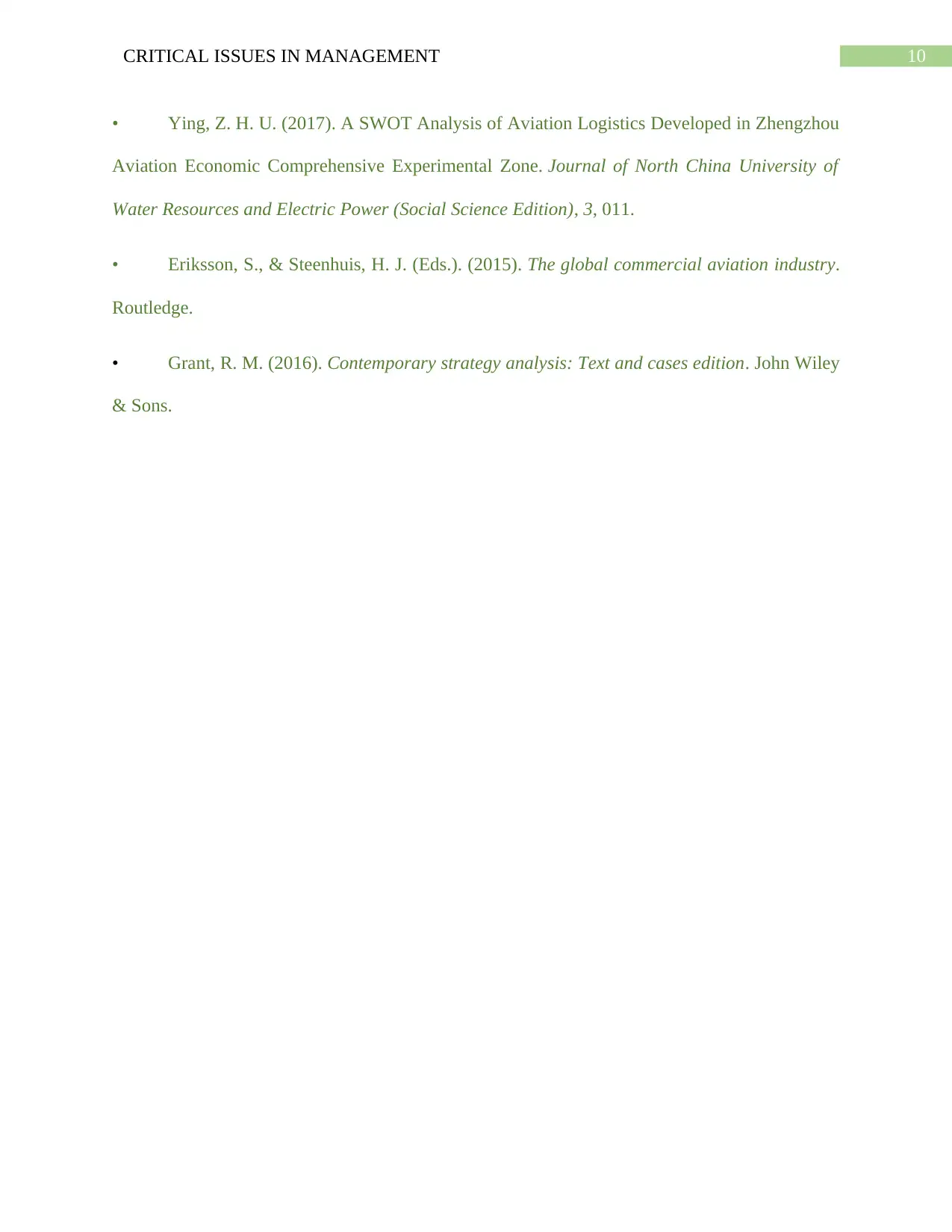
10CRITICAL ISSUES IN MANAGEMENT
• Ying, Z. H. U. (2017). A SWOT Analysis of Aviation Logistics Developed in Zhengzhou
Aviation Economic Comprehensive Experimental Zone. Journal of North China University of
Water Resources and Electric Power (Social Science Edition), 3, 011.
• Eriksson, S., & Steenhuis, H. J. (Eds.). (2015). The global commercial aviation industry.
Routledge.
• Grant, R. M. (2016). Contemporary strategy analysis: Text and cases edition. John Wiley
& Sons.
• Ying, Z. H. U. (2017). A SWOT Analysis of Aviation Logistics Developed in Zhengzhou
Aviation Economic Comprehensive Experimental Zone. Journal of North China University of
Water Resources and Electric Power (Social Science Edition), 3, 011.
• Eriksson, S., & Steenhuis, H. J. (Eds.). (2015). The global commercial aviation industry.
Routledge.
• Grant, R. M. (2016). Contemporary strategy analysis: Text and cases edition. John Wiley
& Sons.
1 out of 11
Related Documents
Your All-in-One AI-Powered Toolkit for Academic Success.
+13062052269
info@desklib.com
Available 24*7 on WhatsApp / Email
![[object Object]](/_next/static/media/star-bottom.7253800d.svg)
Unlock your academic potential
Copyright © 2020–2025 A2Z Services. All Rights Reserved. Developed and managed by ZUCOL.





